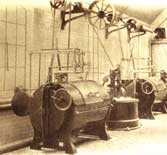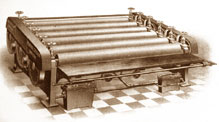| Before
I get to the specific example of the Seattle Empire,
I would like to talk about early twentieth-century laundries
in general. The commercial laundry industry was born
and rapidly matured in the late nineteenth and early
twentieth centuries. In the process, it developed its
own infrastructure of equipment manufacturers and distributors,
soap and chemical suppliers, trade associations, and
educators such as Lydia Ray Balderston, who published
a book entitled 'Laundering' in 1914.
 The
title page credits Balderston as an "Instructor
of Laundering" at the Teachers' College of Columbia
University in New York City. She provides an in-depth
description of the laundering process, which basically
involved four steps. The plan
of a hotel laundry from a turn of the century magazine,
National Laundry Journal, illustrates the basic process. The
title page credits Balderston as an "Instructor
of Laundering" at the Teachers' College of Columbia
University in New York City. She provides an in-depth
description of the laundering process, which basically
involved four steps. The plan
of a hotel laundry from a turn of the century magazine,
National Laundry Journal, illustrates the basic process.
First,
the dirty laundry was marked to identify its owner and
sorted by fabric and type of item. Next, the laundry
was washed by large cylindrical machines, after which
the wet goods were transferred to extractors (see picture
above left) where moisture was removed by centrifugal
force. This is the equivalent of the spin cycle in modern
washers.
The
items were then dried, sometimes by being placed in
a heated drying room, and, finally, "finished,"
which might entail starching, ironing, folding, and
mending.
 Right
is another central piece of equipment, an ironing 'mangle'.
Authors such as Balderston spent a good deal of time
describing the ideal facilities for both home and commercial
laundries. A few passages from her book outline the
main concerns associated with commercial laundry design: Right
is another central piece of equipment, an ironing 'mangle'.
Authors such as Balderston spent a good deal of time
describing the ideal facilities for both home and commercial
laundries. A few passages from her book outline the
main concerns associated with commercial laundry design:
"The
whole room or rooms should be built with the idea of good
ventilation and good light, and with every consideration
that will promote the best sanitary conditions...If
the plant is very extensive, it naturally must reach in
height, and in this case the division of department is
brought about by having each department on a floor by
itself. Height of building overcomes expense of land,
but of course involves expense of elevators and lifts,
as well as more supervision by heads of departments...The
windows in the laundry should be large, and for extra
ventilation a transom over each. This transom allows fresh
air to enter the laundry without the hindrance of this
air blowing directly on the work, which not only dries
the garment about to be ironed, but cools the iron...
"Driers
that are like rooms should be ventilated to allow
escape for moisture and steam, and to increase the
ventilation, those that do the most rapid drying are
equipped with an electric fan..."
"The
ironing section of the room should have good light,
because of the uncertainty of scorching clothes, as
well as being able to see when the wrinkles are ironed
out."
Some
general information on real - versus academically ideal
- laundry facilities is provided by contemporary government
reports. The coming of age of the commercial laundry
industry was in 1907, when it was found by the U.S.
Department of Commerce to be of sufficient importance
to merit an industrial census. Six years later, in the
year that the Empire Laundry was built, the federal
Bureau of Labor Statistics studied women workers in
power laundries in Milwaukee.
The
laundry industry in that city was felt to be representative
of other urban areas throughout the country. Of the
31 laundries in Milwaukee at that time, only 13 were
in buildings specifically designed for that purpose.
Others were located in reconstructed houses or modified
commercial buildings. Despite their relatively small
number, the 13 purpose-built laundries "employed
70 per cent of all the power-laundry workers in Milwaukee
and did approximately 80 per cent of all the laundry
work done in the city.
|